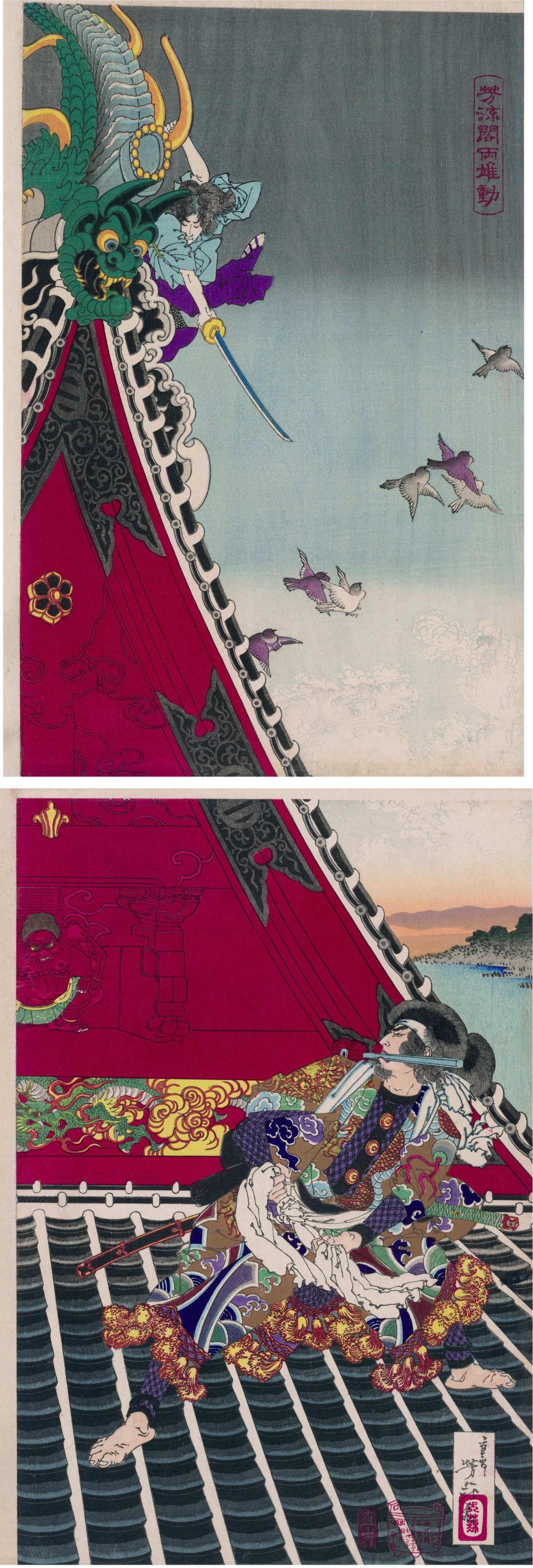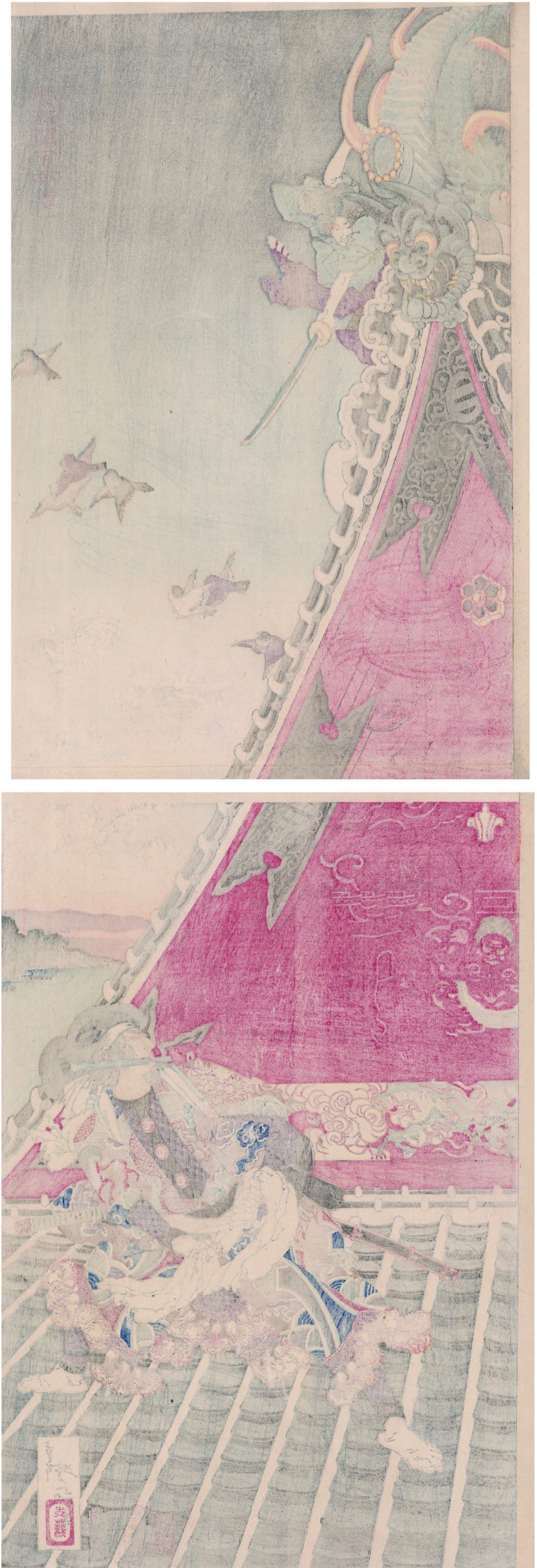Yoshitoshi | Inuzuka Shino and Inukai Gempachi fighting on the roof of Horyukaku
月岡芳年 Tsukioka Yoshitoshi(1839–1892)
芳凉阁两雄动
Inuzuka Shino and Inukai Gempachi fighting on the roof of Horyukaku
1887
木版画 | 双联续绘-纵绘大判 | 70cm x 25cm
Woodblock-print | Diptych-Oban-tate-e | 70cm x 25cm
非常早期的印刷;颜色鲜艳;整体品相非常好;上方边缘经轻微修剪
Very early impression; strong color; great condition; slightly trimmed on upper margin
《南总里见八犬传》,简称《八犬传》,是一部日本文学史上罕见的长篇巨著。全书原版共98卷,106册,由江户时代著名小说家曲亭马琴(1767-1848)花费二十八载写就,堪称其半生呕心沥血之作。全书以室町时代后期为背景,讲述了因安房里见家公主伏姬与神犬八房的情缘而产生命运纠葛的八位年轻义士的波澜事迹。因八人姓氏中皆含“犬”字,故称“八犬”。出生于关八州各地的他们,经历重重磨难,因各种因缘际会而相遇相识,最终于武家里见氏的门下并聚团圆。
芳凉阁,即芳流阁,书中虚拟建筑物,是经典章节芳流阁之决斗的发生地。暮色远苍山,归鸟惊飞。被日光晒得还未退却炽热的三层橹芳流阁朱漆雕栏,龙游斗拱,忽只见檐上,两名义士剑拔弩张:高处攀鬼面鸱吻背棘,一袭蓝紫衣装扮的为犬冢信乃,乃是全书第一位登场的“犬”义士,正手持足利家宝刀村雨丸,以寒光凛凛应战;画面下方口衔六角十手,双手系紧腰带,身着云龙海波纹织锦的猛士名唤犬饲现八,武艺高超,是一位技艺精湛的高阶捕手。两“犬”相见,分外眼红,一场大战似乎在所难免。此作笔触细腻,配色大胆,构图奇险,越看越叫人手里捏一把汗,不愧为《八犬传》题材浮世绘中的佼佼者。
Interested in purchasing?
Please contact us.
月岡芳年 Tsukioka Yoshitoshi(1839–1892)
芳凉阁两雄动
Inuzuka Shino and Inukai Gempachi fighting on the roof of Horyukaku
1887
木版画 | 双联续绘-纵绘大判 | 70cm x 25cm
Woodblock-print | Diptych-Oban-tate-e | 70cm x 25cm
非常早期的印刷;颜色鲜艳;整体品相非常好;上方边缘经轻微修剪
Very early impression; strong color; great condition; slightly trimmed on upper margin
《南总里见八犬传》,简称《八犬传》,是一部日本文学史上罕见的长篇巨著。全书原版共98卷,106册,由江户时代著名小说家曲亭马琴(1767-1848)花费二十八载写就,堪称其半生呕心沥血之作。全书以室町时代后期为背景,讲述了因安房里见家公主伏姬与神犬八房的情缘而产生命运纠葛的八位年轻义士的波澜事迹。因八人姓氏中皆含“犬”字,故称“八犬”。出生于关八州各地的他们,经历重重磨难,因各种因缘际会而相遇相识,最终于武家里见氏的门下并聚团圆。
芳凉阁,即芳流阁,书中虚拟建筑物,是经典章节芳流阁之决斗的发生地。暮色远苍山,归鸟惊飞。被日光晒得还未退却炽热的三层橹芳流阁朱漆雕栏,龙游斗拱,忽只见檐上,两名义士剑拔弩张:高处攀鬼面鸱吻背棘,一袭蓝紫衣装扮的为犬冢信乃,乃是全书第一位登场的“犬”义士,正手持足利家宝刀村雨丸,以寒光凛凛应战;画面下方口衔六角十手,双手系紧腰带,身着云龙海波纹织锦的猛士名唤犬饲现八,武艺高超,是一位技艺精湛的高阶捕手。两“犬”相见,分外眼红,一场大战似乎在所难免。此作笔触细腻,配色大胆,构图奇险,越看越叫人手里捏一把汗,不愧为《八犬传》题材浮世绘中的佼佼者。
Interested in purchasing?
Please contact us.
月岡芳年 Tsukioka Yoshitoshi(1839–1892)
芳凉阁两雄动
Inuzuka Shino and Inukai Gempachi fighting on the roof of Horyukaku
1887
木版画 | 双联续绘-纵绘大判 | 70cm x 25cm
Woodblock-print | Diptych-Oban-tate-e | 70cm x 25cm
非常早期的印刷;颜色鲜艳;整体品相非常好;上方边缘经轻微修剪
Very early impression; strong color; great condition; slightly trimmed on upper margin
《南总里见八犬传》,简称《八犬传》,是一部日本文学史上罕见的长篇巨著。全书原版共98卷,106册,由江户时代著名小说家曲亭马琴(1767-1848)花费二十八载写就,堪称其半生呕心沥血之作。全书以室町时代后期为背景,讲述了因安房里见家公主伏姬与神犬八房的情缘而产生命运纠葛的八位年轻义士的波澜事迹。因八人姓氏中皆含“犬”字,故称“八犬”。出生于关八州各地的他们,经历重重磨难,因各种因缘际会而相遇相识,最终于武家里见氏的门下并聚团圆。
芳凉阁,即芳流阁,书中虚拟建筑物,是经典章节芳流阁之决斗的发生地。暮色远苍山,归鸟惊飞。被日光晒得还未退却炽热的三层橹芳流阁朱漆雕栏,龙游斗拱,忽只见檐上,两名义士剑拔弩张:高处攀鬼面鸱吻背棘,一袭蓝紫衣装扮的为犬冢信乃,乃是全书第一位登场的“犬”义士,正手持足利家宝刀村雨丸,以寒光凛凛应战;画面下方口衔六角十手,双手系紧腰带,身着云龙海波纹织锦的猛士名唤犬饲现八,武艺高超,是一位技艺精湛的高阶捕手。两“犬”相见,分外眼红,一场大战似乎在所难免。此作笔触细腻,配色大胆,构图奇险,越看越叫人手里捏一把汗,不愧为《八犬传》题材浮世绘中的佼佼者。
Interested in purchasing?
Please contact us.
Tsukioka Yoshitoshi (1839–1892)
Tsukioka Yoshitoshi may have lived for only 53 years, a short lifespan even in Edo times, but the history he witnessed and the myriad styles he embraced could have easily filled twice that many decades. Beginning as a more-or-less classic Ukiyo-e artist of the Utagawa school, in the waning days of the Shogunate, he developed a style that was both in-sync with Western styles and utterly his own. He was there as Japan metamorphized from a feudal land to a nascent modern society, and he managed to capture that elusive moment in time in more than 2000 woodblock prints for more than 50 publishers.
You could say he was the last great Ukiyo-e artist, and perhaps the first great post-Ukiyo-e artist. His fantastical designs ranged from history – often with buckets of blood – to bijin (beautiful women) to landscapes. He depicted people from a variety of angles and gave them intricate, and often grotesque, facial characteristics, a far cry from the simple, stereotypical visages common to Japanese woodblock prints. And he could have fun. One of his last great series, 1888’s “32 Aspects of Women,” humorously shows women through various realms of Japanese culture, and depicts very specifics moods and sensations – for example, “Cool,” “Thirsty” and “Itchy.” My favorite? “Disagreeable: Habits of a young woman of Nagoya in the Ansei era.” Ha! What a pill she looks like.
Yoshitoshi was born into a merchant family in 1839. He was an early student of Kuniyoshi, who gave him his name. Many of his warrior designs, especially the earlier ones, show a clear debt to the master, with all manner of high energy action filling his oban-size prints. He became known as a “war artist” specializing in bloody designs in the 1860s. He did numerous warrior, folklore and history series’ during this period.
But those were not his only genres. He also contributed to the epic “Processional Tokaido,” in which most of the great Ukiyo-e artists and publishers of the time combined forces to depict the Shogun’s journey to Kyoto to pay respects to the Emperor, and did his share of “Yokohama-e,” prints depicting the newly arrived Westerners.
His creativity was evident here, as he even went so far as to imagine what one of the foreign countries, France, looked like in one 1866 print. (This is one of my favorites in XZ Ukiyoe’s collection.)
He was tormented by a mysterious mental disorder – some say that’s what sparked such a violent imagination – and had numerous marriages and amorous affairs. He stopped working for a period, and when he came back called himself Taiso – resurrection. By the 1880’s his talent reached it’s zenith, with his epic “100 Aspects of the Moon,” and other series. His drawings and color schemes became more elaborate and more, well, his. They switched easily between bold and blunt and delicate and sensitive (and back again). Still suffering from mental illness, he died in 1892.
Partial citation: Marks, Andreas, Japanese Woodblock Prints, Artists, Publishers and Masterworks (Tuttle; 2010).


